-
The Impossibles by Kristine Kathryn Rusch
Rusch is usually a reliable author of good entertaining stories and this court-drama is no exception. It is part of her Retrieval Artist stories, but I only realized that afterwards and the story is perfectly fine on its own.
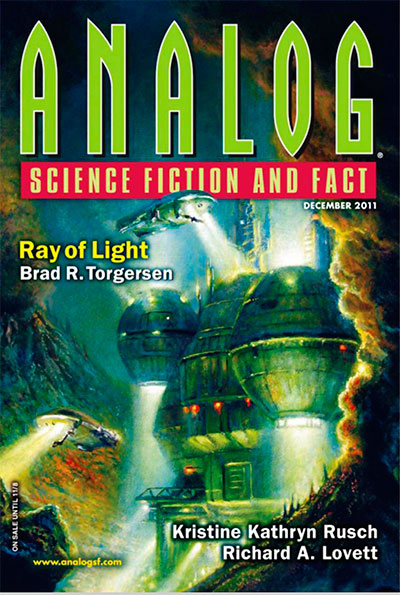
The story follows a lawyer trying to do her best in an interspecies court system where humans have to accept being prosecuted by alien law. This has created a very stressful system for the lawyers, where the best case scenario usually is just a reduced sentence, even though the crime is something small like stepping on a flower or simply touching a specific alien.
As what is often a main ingredient in these types court room dramas, a special case comes along that needs some creative thinking and the use of loopholes in some old laws. That aspect of the story is fine, but the highlight for me was the whole background setting, where we get small drops of details about how this whole ordeal is one big diplomatic trade between Earth and various aliens in order to get access to the galactic trade network. Rich people can of course buy their way out of trouble, but regular people just have to accept being judged cruelly by alien laws they have little way of avoiding. In addition, the main character is a likeable type that really tries to good within the system. All in all a fairly straight forward story that mostly goes where you expect it to, but it was an enjoyable and entertaining read.
Read in Analog December 2011
Rating: 3+ -
Ray of Light by Brad R. Torgersen
Aliens have turned down the light from the sun causing a global iceage and humans have fled into underground habitats where there is still some heat from the Earths core. A few decades later, some teenagers want to see the sun and the sky - even though they have only heard about in stories from their parents. They set out to make it happen by taking some submarines further than anyone has ever done.

This plot unfolds between the present where a father is searching for his daughter and uncovering what she and her friends are up to, and some flashback scenes from when the girl was younger in which she and we as readers gets some more background on the events that led to this.
This story is quite similar to “A Pail of Air”. Similar premise and same theme about humans finding almost poetic hope in a terrible situation. In places Torgersens tend to be a bit on the sentimental side, but I was still somewhat moved by the story and how it portrays the need for hope and optimism in desperate situations.
Read in Analog December 2011
Rating: 3+ -
What We Call Science, They Call Treason by Dominica Phetteplace
This story is set in a near future Silicon Valley where a tech billionaire gets his friend to test a prototype of a bracelet that is able to detect the current mood of the wearer. It glows different colors depending on whether the person is intrigued, skeptical, afraid, excited and so on.
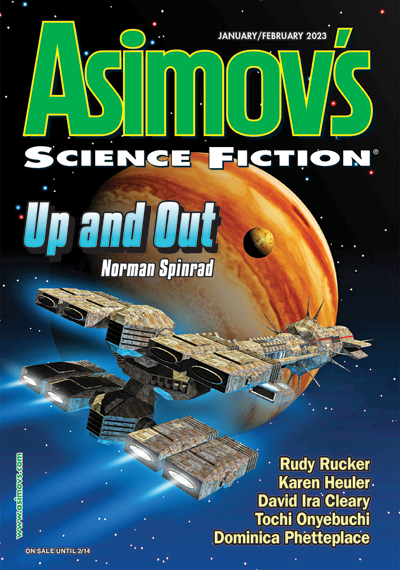
At least that is where it begins, because the story quickly takes some wild turns where we end up in a parallel world with an highly advanced Roman empire. Apparently, the tech billionaire has stolen some of his tech through a portal to this world.
There are quite a few interesting concepts introduced here and a couple of noteworthy jabs at the tech billionaires of the present, but it is simply too many things crammed into too few pages. The story starts in a normal pace, then quickly goes into overdrive and then it is all over with a couple of timelapse paragraphs. These kind of ideas could really have benefited from at least a novella to come properly together.
Read in Asimov’s January/February 2023
Rating: 2 -
Off the Map by Dane Kuttler
This debut story had a setup that reminded me of “Welcome Home” by Jendayi Brooks-Flemister in Asimov’s January/February 2022. In a dystopian future Ava is struggling raising her three children alone and she is under constant surveillance by the government. Even minor missteps might get her to lose custody of her kids. One day she gets an offer to relocate to a company owned small community town in Florida and she see no other option to accept.
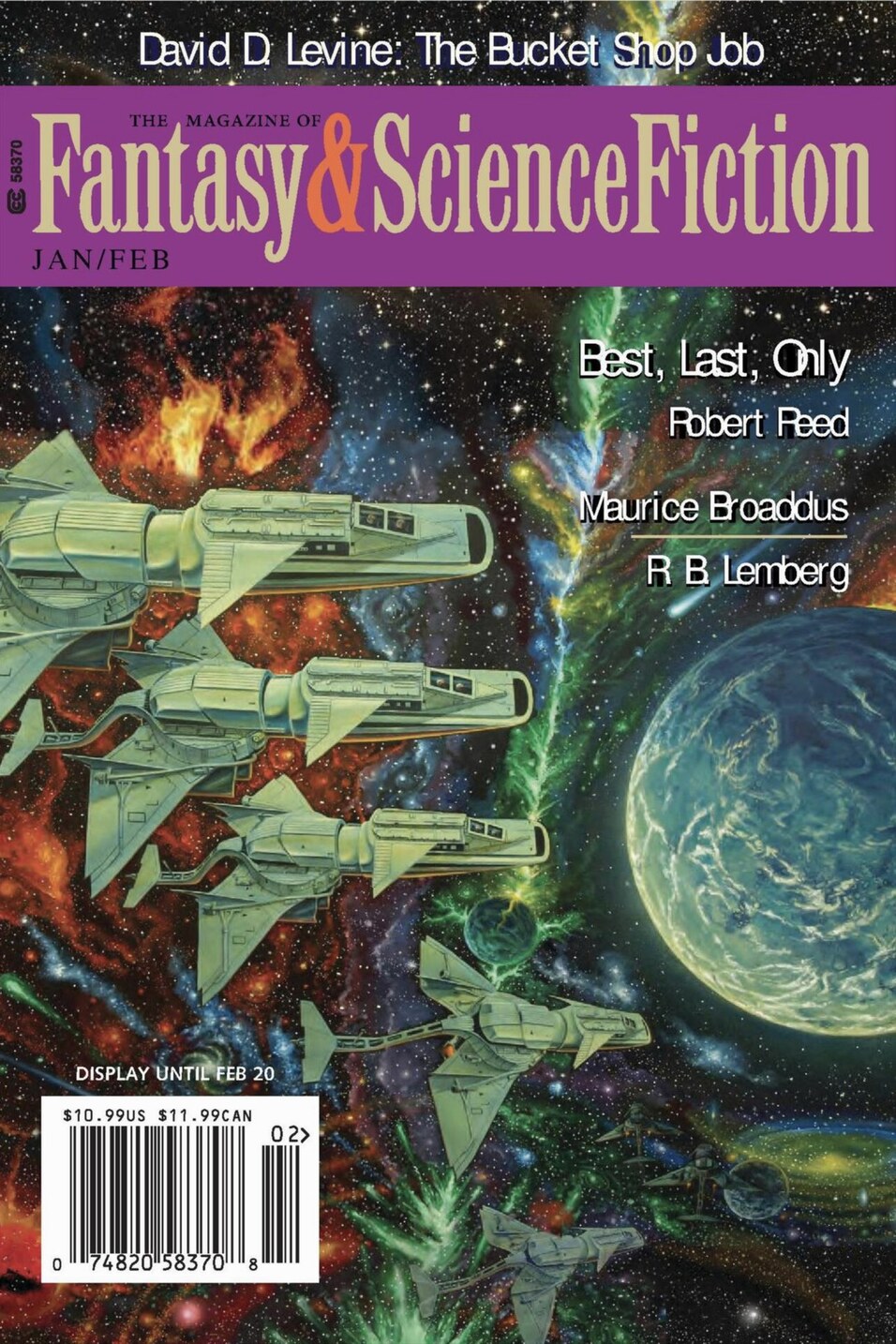
At her new home she meets with other families like herself and the staff that treats her and her kids well. Their basic needs are taken care of, the kids can go to a good school and everyone is helping one another in this small community. It is almost paradise. Ava barely has time to question the whole thing, but we as readers are just waiting for the catch or the twist. It has an overtone of everything being too good to be true.
Unsurprisingly there is a twist at the end that turns things around, but I found it to be a very rushed and a bit unlikely ending. Still, this is a debut story and I genuinely think the author has successfully written an engaging story with properly developed characters, but the actual plot could use some work.
Read in Fantasy & Science Fiction, January/February 2023
Rating: 2+ -
Up and Out by Norman Spinrad
This long novella was a tough one to get through. It is basically one long love letter homage to Elon Musk. Even without the recent Twitter debacle I don’t think Musk is someone who deserves much praise. He might have grand ideas about humans colonizing space in the near future, that can seem admirable especially for science fiction fans. But with his complete lack of basic human decency, I wouldn’t wish for a future led by people like him. At times I was unsure whether this whole thing is meant as satire, but I actually don’t think so.

The story takes place at least 100 years in the future and a slow colonization of the solar system is in progress. The story is told like a journal and autobiography by a business man who has named himself Elon Tesla in honor of Musk - who allegedly showed humans the way to colonize space. Now Elon Tesla takes the credit for terraforming Mars, building space habitats around Jupiter and the creation of hibernation technology allowing humans to travel great distances in time and space without reducing their biological lifespan. The background frame around Teslas lifestory is the discovery of an alien spacecraft on course for Earth that will reach us in a thousand years. And he wants to meet them.
The whole Elon Musk fanism is bad enough but even if I tried to read it with that name erased, the story is really just very boring. Things are told with broad strokes about all the big developments without any details. A story written as an autobiography really needs an interesting character to be worth it, but Elon Tesla has basically no personality at all. It is unclear what he even does. He is not a brilliant engineer inventing stuff making it all possible. He doesn’t even has the big ideas. Seemingly all he does is provide funding for other peoples ideas and then takes the credit. In that sense, I guess he resembles Elon Musk.
Read in Asimov’s January/February 2023
Rating: 1 -
Upstart by Lu Ban
Clarkesworld continues to bring great translated stories. This story is translated from Chinese by Blake Stone-Banks and is another story that deals with death and especially what makes a life worth living.
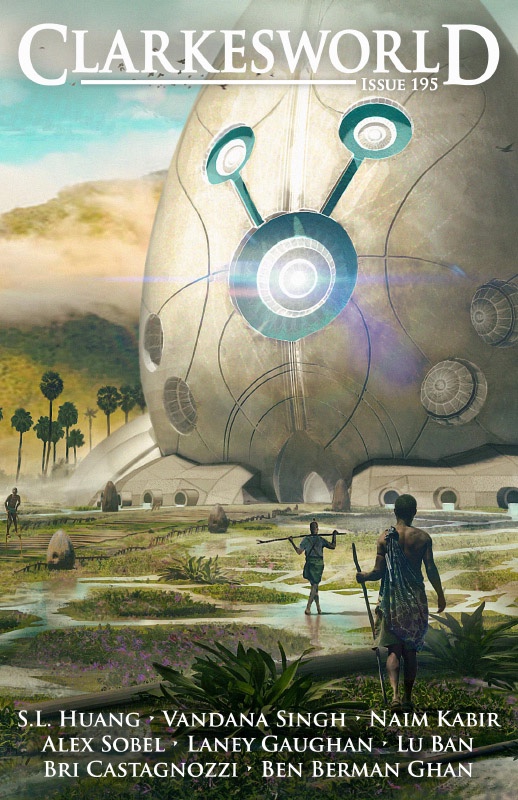
In some unspecified dystopian future a state handles the overpopulation by offering a program that gives people a good deal of money if they accept certain death at a younger age. The story follows a man called K Li who takes such a deal and the story is split between his meeting with an advisor that administers the practicalities when he accepts the deal as a teenager and later in his life when his time is almost up. The deal is enforced with a drug that will slowly and painfully kill when the specified time of death is reached, which can be avoided if they seek out voluntary euthanasia at the states clinic.
Most of the story takes places when K Li is around 40 years old and the drug will soon kill him. He lives in an apartment building with other “upstarts” - the term used for those who have taken this deal. It is clear that even though he got several millions he could use until his death some 20 years later, he hasn’t had a good life. He spends most of his time being passed out drunk in his apartment, not unlike many of the other “upstarts” in his apartment complex. The deal might give people money, but lots of rights are also taken away and the rest of the population seems to resent the “upstarts”.
One day a young woman shows up at his door and convinces him that there might be an antidote for the drug that will soon kill him, and she leads him to what appears to be some sort of resistance group. The story evolves into an exciting thrillerplot with quite a surprising ending.
What I think makes this story work so well and why I would consider it worthy in a “best of the year”-anthology is how it tackles this “deal with Devil”-type scenario with a proper amount of emotional depth without going overboard into melancholy. There is also a pretty exciting thriller plot and both parts are given enough space in the story, so one is not merely a piece to make the other element work. We don’t get a lot of background information on this society or why it handles overpopulation in such a way, but it is not needed to make the story engaging and thought provoking in how to put value on a human life.
Read in Clarkesworld December 2022
Rating: 4 -
The World Turned Upside Down
This anthology published by Baen and edited by Jim Baen, David Drake and Eric Flint collects 29 short stories from “the Golden Age” - mainly from the 40s and 50s. What makes this retrospective anthology unique is the selection criteria used by the editors. They haven’t set out to pick the best of the best stories from that era, though they stand by every story as great, but their choices are based on stories that made a big impression on them at a young age.
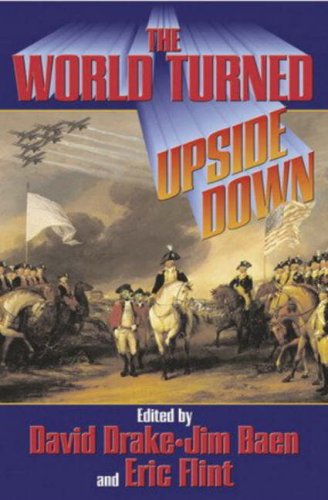
While I have reviewed a couple of the stories here, I don’t think the stories here are what makes this anthology interesting. I greatly appreciate when editors have forewords and/or afterwords to each story, since an anthology is more than just a bunch a stories. I want to hear about why the an editor has chosen a specific story and on what criteria. The three editors are very open and honest about why each an every story is in here. Some stories they have all agreed upon, others are stories that one of the editors really wanted to include for personal reasons. Most of the stories are there because it is a great story that made an impression when they first read it, while some are there because the editors wanted a specific type of story from a certain author represented and couldn’t include a whole novel, even though it was actually the authors novels that they have read as a teenager. Heinlein for example and his story The Menace from Earth are included as an example of his juveniles novels.
While I admire the editors for making an anthology with this very personal criteria, I am not so sure it makes for a great anthology when it comes to the actual stories. There is no false advertisement on this book - they are very honest about why this book is made, so it might not be a fair criticism. Still, most of the stories just made me think that I can see how that could have impressed me as a teenager as well. It has some nostalgic value, even though this is not close to the era of science fiction I grew up with. In certain places, some stories halfway recreates that feeling of being awestruck by simply imagining a whole galaxy filled with alien life.
There are still some great stories that are worth reading by any science fiction fan. Like Omnilingual, Rescue Party, The Aliens or Thunder and Roses. Nevertheless, reading this anthology was mostly a meta-exercise for me. Meaning it was interesting to read stories that clearly have influenced these editors, and probably other writers and editors from the same generation. As well as reading lesser known stories from the Golden Age of science fiction. But it was also mostly a detached intellectual reading. Only a few stories made me forget the premise of the anthology, where I could just enjoy the story on its own.
This anthology is clearly not for everybody. If one wants to read a great selection of amazing stories from that period in time, my recommendation would be The Science Fiction Hall of Fame, Volume One and Two. If you are already well read in the science fiction short story classics, then this anthology will likely give something a bit different.
-
Murder by Pixel: Crime and Responsibility in the Digital Darkness by S.L. Huang
This story is a unique mix of non-fiction and fiction dealing with a very realistic near future technology of chatbots run by AI - especially with the recent ChatGPT.

The story takes the form of a mix between an article referring to past events and a regular short story told from the point of view a reporter. It starts with events leading to a suicide of a businessman who was under investigation for knowingly selling faulty pacemakers. Apparently he got a ton of private messages through various digital channels in the months leading to his suicide. The messages were very demeaning and could have pushed him over the edge to commit suicide. The reporter investigates the origins of these messages in this and similar cases, and through her investigation discovers an automated chatbot named Sylvie. But the bot doesn’t just try to push bad people to commit suicide, it also uses the same machine learned algorithms to help people in need. All this is mixed with various fact infodumps about machine learning technology and some philosophical arguments about the ethical and legal issues of such an autonomous chatbot.
The story is very successful is introducing some interesting dilemmas we might very soon face with current technology. I am just not sure it entirely works as a fiction short story since it is mostly an opinion essay on the subject, but I can also see how using a fictionalized case study to explore the issues makes the morale questions easier to relate to. A story worth reading but a mixed experience.
Read in Clarkesworld December 2022
Rating: 3 -
Sacrificial Drones by John Shirley
There is a lot going on in this near future thriller. Drones, high tech weapons, rejuvenation technology and more all mixed into a fast moving story about an old multibillionaire, a young scientist and murderous villains.
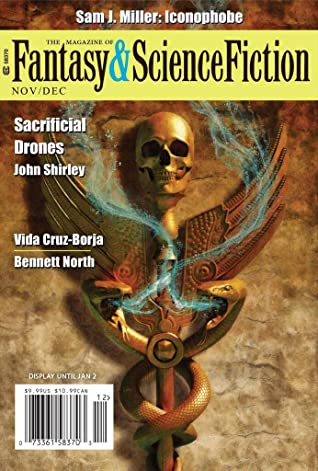
The short story has a tragic prologue about a boy witnessing the assassination of his parents. The story jumps to the year 2049 and early in the story it becomes apparent that the boy is Jacob Maweela - now a rich philanthropist in his 80s who has recently had rejuvenation treatment making him around the age of 30 again. The story is told from the point of view of a young researcher, Kaela, who is approached by Jacob to further develop her nanodrone technology to provider better healthcare in poor countries. However, Jacob is also under constant threat of assassination from the same people who killed his parents. Kaela and Jacob develops sort of a close non-romantic relationship while the plot unfolds.
There are plenty of things to like in this story, but also quite a few issues that make me wish that it was given an extra round of editorial rework to reach its potential. The story lacks focus in my opinion. Too many elements and plotpoints are introduced that it is hard to keep track of what is actually important. The rejuvenation? The technology that can help poor people? The assassination plot? The relationship between Jacob and Kaela? All fascinating topics on their own, but the story is not long enough to give enough depth or meaning to much of it. The main focus seems to be Jacobs internal struggle with how he can protect his family and employees from the death threats, but since the story is told from Kaelas viewpoint, we only get a distanced look at Jacobs thoughts and actions.
The author does manage to create a very authentic and believable future, which makes the story recommendable, but I feel it is also a missed opportunity for a tighter and more focused plot.
Read in Fantasy & Science Fiction, November/December 2022
Rating: 3 -
Jazz Age by Mark Tiedemann
This long novella is set in a future where humans have been in contact with an alien race called the Trishti for about 50 years. These aliens tell of a huge galaxy with plenty of other peaceful aliens. But humans must develop their own stardrive first to join this galactic community, while the Trishti are helping in small ways.
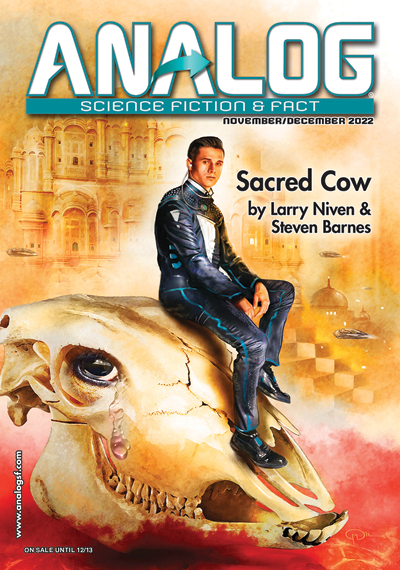
The author paints a peaceful and prosperous future in this scenario, where humans have adapted a lot of Trishti culture like naming their children inspired by Trishti names. Most people seem to like the aliens, but a few are also skeptical because humans have now become so dependent on them.
The plot gets going when the leader of the Omicron-project, the project that is working on the stardrive, declares they have succeeded. The Trishti then announce that their work here is done and starts to leave. However - the project is nowhere near finished and it was all a lie that somehow should have deceived the Trishti into revealing more of their secrets. This sets several things in motion with a political and diplomatic scandal as people try to convince the Trishti to stay. But the aliens may also have their own secrets that turns things around.
This story has plenty of good elements for an interesting thriller with mysterious aliens, political intrigue and deceitful plot treads. It is slow going though and the story is too long. It presents some interesting glimpes of how society has changed with 50 years of influence from the aliens, but it isn’t used for that much in the story. Also, most of the plot development is driven by people keeping various secrets and only reveal them when the story needs it. It is not my favorite way of storytelling, but the plot twists are interesting in their own right. Throughout the story there are a few mentions of the Trishtis music, which I assume explains the title of the story, but it was never really clear to me why that element should be so important - other than being something intriguing about them.
Read in Analog November/December 2022
Rating: 3